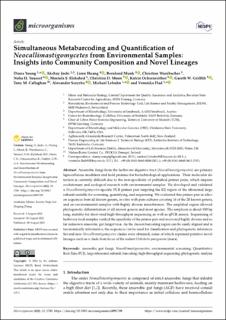Please use this identifier to cite or link to this item:
https://doi.org/10.21256/zhaw-25733Full metadata record
| DC Field | Value | Language |
|---|---|---|
| dc.contributor.author | Young, Diana | - |
| dc.contributor.author | Joshi, Akshay | - |
| dc.contributor.author | Huang, Liren | - |
| dc.contributor.author | Munk, Bernhard | - |
| dc.contributor.author | Wurzbacher, Christian | - |
| dc.contributor.author | Youssef, Noha H | - |
| dc.contributor.author | Elshahed, Mostafa S | - |
| dc.contributor.author | Moon, Christina D | - |
| dc.contributor.author | Ochsenreither, Katrin | - |
| dc.contributor.author | Griffith, Gareth W | - |
| dc.contributor.author | Callaghan, Tony M | - |
| dc.contributor.author | Sczyrba, Alexander | - |
| dc.contributor.author | Lebuhn, Michael | - |
| dc.contributor.author | Flad, Veronika | - |
| dc.date.accessioned | 2022-09-30T14:39:59Z | - |
| dc.date.available | 2022-09-30T14:39:59Z | - |
| dc.date.issued | 2022 | - |
| dc.identifier.issn | 2076-2607 | de_CH |
| dc.identifier.uri | https://digitalcollection.zhaw.ch/handle/11475/25733 | - |
| dc.description.abstract | Anaerobic fungi from the herbivore digestive tract (Neocallimastigomycetes) are primary lignocellulose modifiers and hold promise for biotechnological applications. Their molecular detection is currently difficult due to the non-specificity of published primer pairs, which impairs evolutionary and ecological research with environmental samples. We developed and validated a Neocallimastigomycetes-specific PCR primer pair targeting the D2 region of the ribosomal large subunit suitable for screening, quantifying, and sequencing. We evaluated this primer pair in silico on sequences from all known genera, in vitro with pure cultures covering 16 of the 20 known genera, and on environmental samples with highly diverse microbiomes. The amplified region allowed phylogenetic differentiation of all known genera and most species. The amplicon is about 350 bp long, suitable for short-read high-throughput sequencing as well as qPCR assays. Sequencing of herbivore fecal samples verified the specificity of the primer pair and recovered highly diverse and so far unknown anaerobic gut fungal taxa. As the chosen barcoding region can be easily aligned and is taxonomically informative, the sequences can be used for classification and phylogenetic inferences. Several new Neocallimastigomycetes clades were obtained, some of which represent putative novel lineages such as a clade from feces of the rodent Dolichotis patagonum (mara). | de_CH |
| dc.language.iso | en | de_CH |
| dc.publisher | MDPI | de_CH |
| dc.relation.ispartof | Microorganisms | de_CH |
| dc.rights | https://creativecommons.org/licenses/by/4.0/ | de_CH |
| dc.subject | Neocallimastigomycetes | de_CH |
| dc.subject | Quantitative Real-Time PCR | de_CH |
| dc.subject | Anaerobic gut fungi | de_CH |
| dc.subject | Barcoding | de_CH |
| dc.subject | Environmental screening | de_CH |
| dc.subject | High-throughput sequencing | de_CH |
| dc.subject | Large ribosomal subunit | de_CH |
| dc.subject | Phylogenetic analysis | de_CH |
| dc.subject.ddc | 660.6: Biotechnologie | de_CH |
| dc.title | Simultaneous metabarcoding and quantification of neocallimastigomycetes from environmental samples : insights into community composition and novel lineages | de_CH |
| dc.type | Beitrag in wissenschaftlicher Zeitschrift | de_CH |
| dcterms.type | Text | de_CH |
| zhaw.departement | Life Sciences und Facility Management | de_CH |
| zhaw.organisationalunit | Institut für Chemie und Biotechnologie (ICBT) | de_CH |
| dc.identifier.doi | 10.3390/microorganisms10091749 | de_CH |
| dc.identifier.doi | 10.21256/zhaw-25733 | - |
| dc.identifier.pmid | 36144352 | de_CH |
| zhaw.funding.eu | No | de_CH |
| zhaw.issue | 9 | de_CH |
| zhaw.originated.zhaw | Yes | de_CH |
| zhaw.pages.start | 1749 | de_CH |
| zhaw.publication.status | publishedVersion | de_CH |
| zhaw.volume | 10 | de_CH |
| zhaw.publication.review | Peer review (Publikation) | de_CH |
| zhaw.webfeed | Umweltbiotechnologie und Bioenergie | de_CH |
| zhaw.funding.zhaw | Entfesselung des versteckten Potentials anaerober Pilze (Neocallimastigomycota) | de_CH |
| zhaw.author.additional | Yes | de_CH |
| zhaw.display.portrait | Yes | de_CH |
| Appears in collections: | Publikationen Life Sciences und Facility Management | |
Files in This Item:
| File | Description | Size | Format | |
|---|---|---|---|---|
| 2022_Young-etal_Simultaneous-metabarcoding-quantification-neocallimastigomycetes.pdf | 4.17 MB | Adobe PDF |  View/Open |
Show simple item record
Young, D., Joshi, A., Huang, L., Munk, B., Wurzbacher, C., Youssef, N. H., Elshahed, M. S., Moon, C. D., Ochsenreither, K., Griffith, G. W., Callaghan, T. M., Sczyrba, A., Lebuhn, M., & Flad, V. (2022). Simultaneous metabarcoding and quantification of neocallimastigomycetes from environmental samples : insights into community composition and novel lineages. Microorganisms, 10(9), 1749. https://doi.org/10.3390/microorganisms10091749
Young, D. et al. (2022) ‘Simultaneous metabarcoding and quantification of neocallimastigomycetes from environmental samples : insights into community composition and novel lineages’, Microorganisms, 10(9), p. 1749. Available at: https://doi.org/10.3390/microorganisms10091749.
D. Young et al., “Simultaneous metabarcoding and quantification of neocallimastigomycetes from environmental samples : insights into community composition and novel lineages,” Microorganisms, vol. 10, no. 9, p. 1749, 2022, doi: 10.3390/microorganisms10091749.
YOUNG, Diana, Akshay JOSHI, Liren HUANG, Bernhard MUNK, Christian WURZBACHER, Noha H YOUSSEF, Mostafa S ELSHAHED, Christina D MOON, Katrin OCHSENREITHER, Gareth W GRIFFITH, Tony M CALLAGHAN, Alexander SCZYRBA, Michael LEBUHN und Veronika FLAD, 2022. Simultaneous metabarcoding and quantification of neocallimastigomycetes from environmental samples : insights into community composition and novel lineages. Microorganisms. 2022. Bd. 10, Nr. 9, S. 1749. DOI 10.3390/microorganisms10091749
Young, Diana, Akshay Joshi, Liren Huang, Bernhard Munk, Christian Wurzbacher, Noha H Youssef, Mostafa S Elshahed, et al. 2022. “Simultaneous Metabarcoding and Quantification of Neocallimastigomycetes from Environmental Samples : Insights into Community Composition and Novel Lineages.” Microorganisms 10 (9): 1749. https://doi.org/10.3390/microorganisms10091749.
Young, Diana, et al. “Simultaneous Metabarcoding and Quantification of Neocallimastigomycetes from Environmental Samples : Insights into Community Composition and Novel Lineages.” Microorganisms, vol. 10, no. 9, 2022, p. 1749, https://doi.org/10.3390/microorganisms10091749.
Items in DSpace are protected by copyright, with all rights reserved, unless otherwise indicated.